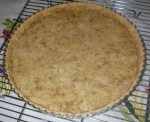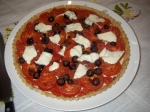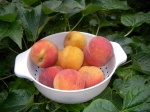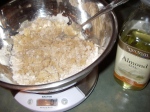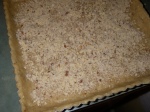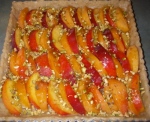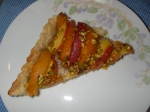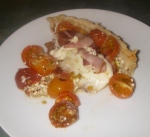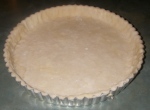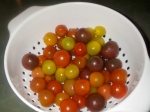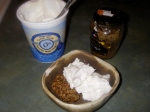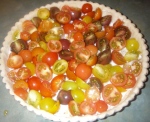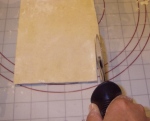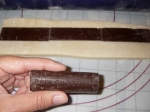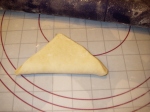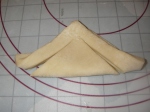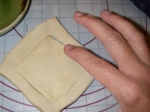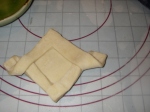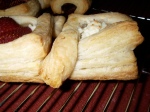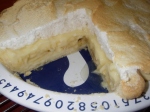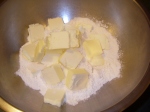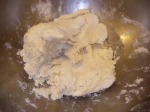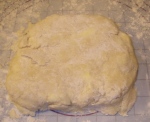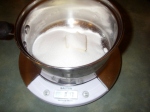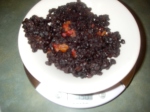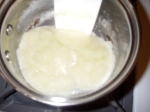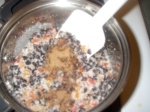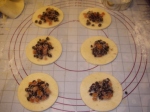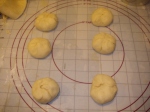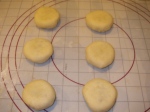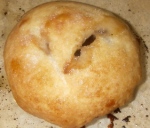Okay, technically this isn’t baking, but breakfast is my favorite meal, and I don’t mind cooking for it.

Eggs Benedict with a side of blackberries
Today I tried yet another English muffin recipe, this one from
The Professional Pastry Chef. This one is dough more than batter, and I didn’t like it very much. On the other hand, I feel like I’m getting the hang of using the stove-top griddle, so that’s good. I think the best muffin recipe so far is Ciril Hitz’s, which I’ll try on the griddle next time. Ciril wants you to bake his muffins in the oven.
The part of eggs Benedict that everyone worries about is the hollandaise sauce. I’ve only ever made it from Mastering the Art of French Cooking, and it’s always turned out perfectly. Julia’s instructions are excellent, and if you follow them and pay attention, it’s easy.
Hollandaise Sauce
(from Mastering the Art of French Cooking)
Makes 1 to 1½ cups, enough for 4 to 6 servings
3 egg yolks
1 T cold water
1 T lemon juice
big pinch of salt
2 T cold butter cut in half (2 1-T pieces of cold butter)
6 to 8 oz butter (1½ to 2 sticks), melted
salt and white pepper to taste
a few drops of lemon juice to taste
To melt the butter, I cut it up into a big measuring cup (you have to pour it into the sauce later) and microwave it until it’s all melted. What works for me is 30 seconds on medium high, stir, repeat twice. Do that first and set it aside. When you’re ready for the melted butter, you want it to be warm but not hot.
Separate the eggs and put the yolks into a small, heavy-bottomed saucepan. (You can use a double boiler, but I never have.) Beat the yolks with a wire whip for a couple of minutes until they’re thick and sticky. Add the water, lemon juice, and salt and beat for another 30 seconds.
Put 1 tablespoon of the cold butter into the saucepan with the yolks. Put the pan on the stove over very low heat and, using the wire whip, stir the yolks and butter until you have a thick homogeneous mixture. This takes me about 2 minutes. You know you’re there “when you can begin to see the bottom of the pan between strokes, and the mixture forms a light cream on the wires of the whip.”
Remove the pan from the heat. Seriously, take it totally off the stove; you’re done using the stove for the sauce now. Whisk in the other tablespoon of cold butter. This will cool the yolks and stop the cooking.
Whisking the sauce constantly, pour in the melted butter “by droplets” until the sauce begins to thicken, at which point you can pour the butter in a thin stream. When you’re down to the milk solids at the bottom, stop.
Season with salt and white pepper and a little lemon juice to taste.
Eggs Benedict
For each person:
1 English muffin, split
2 slices of cooked Canadian-style bacon
2 poached eggs
Hollandaise sauce
You can have everything ready but the eggs and start assembling the servings while the eggs poach.
Lay the halves of English muffin on a plate, crumb up.
Place one slice of Canadian bacon on each muffin half.
When the eggs are done, remove each one from the water and lay it on the Canadian bacon.
Pour Hollandaise sauce over the eggs.
Reference
Sauce Hollandaise. In Julia Child, Simone Beck, Louisette Bertholle: Mastering the Art of French Cooking (vol. 1). New York, Alfred A. Knopf, 1962, p. 79.

